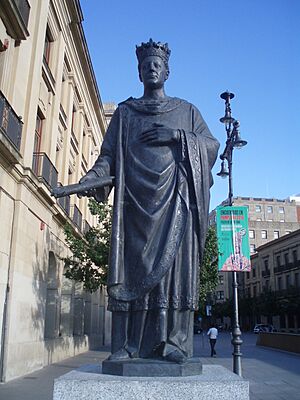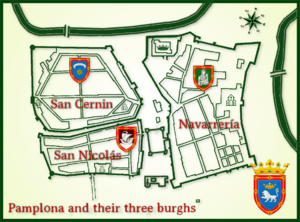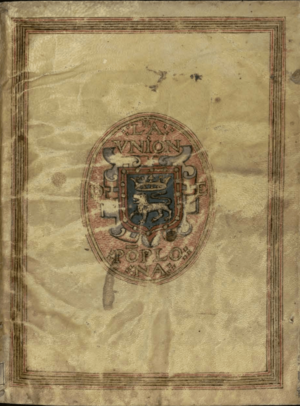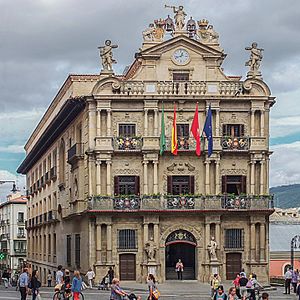Privilege of the Union facts for kids
The Privilege of the Union was a very important law in Navarre. It was signed on September 8, 1423, by King Charles III the Noble. This law brought together the three main parts of Pamplona – La Navarrería, Burgo de San Cernin, and Población de San Nicolás – into one single city. Before this, these three areas acted like separate towns, often having arguments and even fights.
The main goal of the Privilege of the Union was to stop these old disputes and create one united city council for Pamplona. After this law, Pamplona got a new city flag and started building new defensive walls to connect the separate areas. This also led to new streets being built, like Calle Nueva, which you can still see today in the old part of the city.
King Charles III made this document a special kind of law called a Fuero. He gathered the important people of Navarre, called the Cortes de Navarra, to make sure everyone agreed to follow this new law forever. The city of Pamplona was governed by the rules of the Privilege of the Union for a very long time, from 1423 until 1836.
Contents
Why This Law Was Important
To understand why the Privilege of the Union was so important, we need to look at what happened in Pamplona before it. There were some sad events, like the War of the Navarreria in 1272. This war caused a lot of damage to the oldest part of Pamplona, which was built around its cathedral.
How Pamplona Grew
Pamplona was not very populated at the start of the 11th century. Then, King Sancho III the Great (who ruled from 1004-1035) helped to rebuild the old city. This oldest part was called Navarrería. It was the original Roman city, known as Pompaelo.
This area was mostly home to farmers and people who worked for the cathedral. Between 1090 and 1100, more people started moving to Pamplona. Two new settlements grew on the western side of the city:
- The Burgo de San Cernin: This was a settlement of craftsmen and merchants from France.
- The Población de San Nicolás: This area had a mix of French and local people.
These new areas, especially the Burgo de San Cernin, often argued with the older Navarrería. They had their own rules and ways of life. For example, the French settlers in the Burgo de San Cernin received special rights and privileges from King Alfonso I the Battler in 1129. These separate towns had their own walls and were very distinct from each other.
What the Law Said
The Privilege of the Union had 29 chapters, or rules. These rules explained how the new united Pamplona city council should work. They covered many things, such as:
- The city's symbols.
- How to choose mayors and other city officials.
- How to manage justice.
- How to collect taxes.
- How to control weights and measures for trade.
The law also said that this Privilege was a special law for Pamplona. It had to be approved by the three main groups of people in the Kingdom of Navarre. The king and future kings could also change or explain the Privilege if needed.
The City Council Building
The famous building where the Pamplona City Council is located today is quite modern, built in 1950. However, its front part is from the 18th century. This building stands on the exact spot where the first city hall was built. King Charles III ordered it to be built after the Privilege of the Union was signed. This location was chosen because it was right in the middle of the newly united city, outside the old walls of the separate towns.
City Motto
Pamplona has a special motto today: "Very noble, very loyal and very heroic" (Muy noble, muy leal y muy heróica). These titles were given by different kings:
- Very noble: This title was given by King Charles III the Noble when he signed the Privilege of the Union in 1423.
- Very loyal: This title was given by Queen Catherine I of Foix and King John III of Albret in 1486. It recognized Pamplona's loyalty and gave the city more power to handle its own legal matters.
- Very heroic: This title was given by King Ferdinand VII in 1824. It was a reward for Pamplona's bravery and sacrifices during a military attack by the French army the year before.
Yearly Celebration
Every year on September 8, Pamplona celebrates the Privilege of the Union. It's a special day to remember how the city became one.
- The city council often has an open day so people can visit the city hall. They can see the original document that united the three towns.
- An honorary scarf is given to an important person.
- On the weekend closest to September 8, a medieval market is held in the old town. You can see artisans like blacksmiths and furriers, and there are parades and performances in the streets.
- On September 8 itself, the city council, along with the city band (La Pamplonesa) and the famous Troupe of Giants and Bigheads, goes to the cathedral. They pay tribute and offer flowers at the tomb of King Charles III and his wife. After that, they parade through the old town back to the City Hall for dances and a special announcement. Many other events and concerts also take place to celebrate this important day.
See also
 In Spanish: Privilegio de la Unión (1423) para niños
In Spanish: Privilegio de la Unión (1423) para niños





